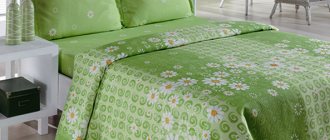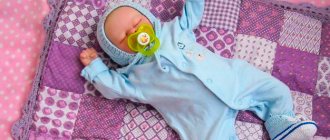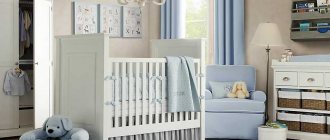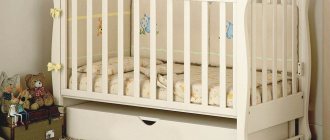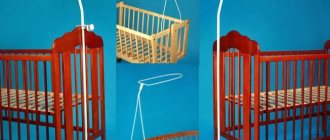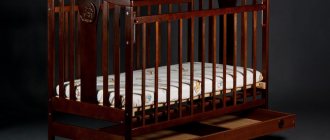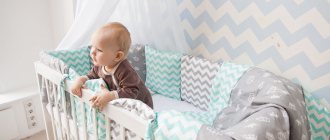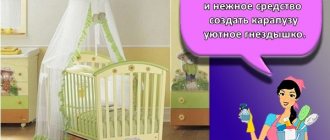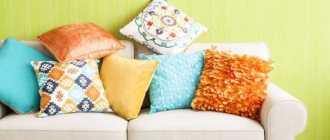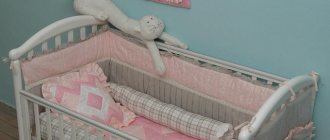Anastasia Isakova 04/04/2017 We do it ourselves Leave a comment 65,947 Views
Some young mothers are wondering: what is better – do-it-yourself bedding for a newborn’s crib or a ready-made store-bought one? The solution to this issue is completely individual, because if a mother knows how to sew and wants to make beautiful and original underwear for her baby, then she will prefer to do it herself. Also, it is necessary to sew linen for a crib for newborns when the bed has a non-standard size.
How to sew baby bedding?
The birth of a child is an exciting and trembling event for all family members.
A newborn baby needs love, extra attention and care. The purchase of children's things, cribs, strollers, bed linen and toys begins long before the baby is born, for whom parents choose only high-quality products from well-known manufacturers. On the shelves of specialized children's stores you can see a huge range of products from this group. The high price of basic necessities surprises not only young parents, but also families who already have children. You can reduce material costs by making children's clothes and bedding yourself.
If mothers who know how to sew and knit can make things for a child, then even parents with minimal knowledge in the field of needlework can sew bedding for a baby.
Which material to choose?
Making your own children's bedding will give you the opportunity not only to choose the material, color and style of the set you need, but also to make bright decorative appliqués.
The right choice of fabric is the key to a child’s comfortable sleep. Experts do not recommend choosing artificial materials. Bed linen that contains cotton is the best option for newborns. Among the main advantages of natural material, the following should be highlighted:
- practicality;
- absence of allergic components;
- delicate texture;
- comfortable sleep.
The most popular sets are made of satin, poplin, calico, phlox, and bamboo.
Most manufacturers prefer calico. Calico has a smooth surface and a loose structure, which promotes the unhindered movement of air and moisture. These indicators are important for newborns.
Advantages:
- high level of density;
- resistance to friction;
- ease of care;
- absence of electrical charges on the surface;
- long-term preservation of shape and color;
- no shrinkage;
- affordable price range;
- Possibility of use at any time of the year.
Disadvantages: pile matting, dull colors.
Poplin is a modern analogue of calico, the sales volumes of which are increasing annually. This material has the following positive parameters:
Among the disadvantages of the material, it can be noted that it rolls up a lot.
It is not advisable to put delicate and soft cotton linen in a baby crib due to its low resistance to mechanical damage and rapid fading of the pattern.
Advantages: affordable price, wide color range, no wrinkles after washing.
Disadvantages: poor thread curl, thinness, wash only in delicate cycle at low temperature.
Satin is a dense material with a smooth surface. It is good in care, but has a serious drawback - the high price range.
Bamboo products not only have high hygroscopicity and moisture permeability, but also have high strength, absorb odor, and have antimicrobial and anti-mite properties.
Nevertheless, the price for such material will not be small at all.
To make a winter bedding set, experts recommend paying attention to flannel. Among the main advantages of the fabric, the following should be highlighted:
- use only natural dyes;
- long period of operation;
- resistance to mechanical friction;
- maintaining a delicate texture after repeated washing;
- heat preservation;
- presence of fleece.
Flaws:
- long drying period;
- high percentage of shrinkage.
Less common types of fabric are: satin, sateen-lux, polyester, ranfors, super-cotton.
Before purchasing the necessary material, be sure to look at the quality certificates, in which the manufacturer indicates the level of safety of the paint used, the density of the threads and their quality. Information about the duration and washing mode is also necessary. The percentage of material shrinkage after washing is reflected in the quantity of goods purchased.
Professional seamstresses recommend choosing material for several sets , the color scheme of which would have common tones, and the products would be harmoniously combined with each other. This trick will help young parents not to change the linen completely, but to remove only the soiled items and exchange them for parts of another set.
The color scheme of children's bedding is a very important indicator that will influence the child's sleep. You cannot choose material with large and bright patterns, which will not only frighten the newborn, but will also look dull and untidy after a large number of washes.
Shades of linen should be calm, warm, and non-aggressive. Professional psychologists recommend giving preference to blue, pink and beige colors.
Convenience
If the child is very active, then it is better to choose a pillowcase with an elastic band, so it will not bunch up. There will be no folds on it, which can also cause skin irritation. Pay attention to the recommendations for washing and ironing. This is also quite important, because bedding for very small children needs to be washed and ironed often.
How to calculate the amount of material?
To ensure that the sewn set does not have to be remade, you need to take the measurements correctly or use standard sizes and make all the necessary calculations.
Standard sizes of children's bedding set:
- pillowcase: height – 40 cm, length – 60 cm;
- sheet: width – 110 cm, length – 140 cm;
- duvet cover: length – 140 cm, width – 100 cm.
Before purchasing fabric, be sure to measure the pillow and mattress, the sizes of which may differ significantly from the standard ones.
To make one standard set, you need to buy at least four meters of material, and for non-standard mattresses and pillows, the fabric consumption is much higher. To this length it is necessary to add at least 15 cm for shrinkage on each product, and for each edge add another 1.5 cm for the seam.
Before you begin the process of cutting out all the pieces of bed linen, you need to do preparatory work, which consists of washing, drying and ironing all the material. These works will lead to shrinkage of the entire material and will eliminate deformation of the finished products.
To rationally use fabric, it is necessary to correctly arrange all elements of the product on the canvas. Experienced seamstresses and specialized literature will tell you the rules for the simultaneous arrangement of all parts of the bedding set.
These rules will help reduce the amount of waste and unnecessary leftover material.
Using a ruler and chalk, you must draw all the necessary lines, the size of which must correspond to the measurements taken. Instead of chalk, you can use small and thin remnants of toilet soap.
Sewing a duvet cover
For a blanket measuring 140x110 cm, you need to fold a piece of fabric in half and cut the material 143 cm long. Sew the duvet cover from the wrong side, folding the fabric face inward. It is better to finish the internal seams with an overlock or zigzag stitch.
On the side seam on one side it is necessary to leave a hole for threading a blanket 30-40 cm long. Carefully stitch the hole itself, folding the fabric in half. Turn the duvet cover inside out and iron it thoroughly, straightening the corners.
On video: how to sew a children's duvet cover.
How to sew correctly?
Making bed linen with your own hands may seem like a labor-intensive process, but this type of work has a number of undeniable advantages:
- production of a set of the required size;
- independent choice of design and color scheme;
- rational use of the family budget.
Before you start sewing bed linen yourself, you need to take care of purchasing the necessary tools and equipment:
- centimeter;
- rulers;
- sewing needles;
- cutting scissors;
- dry chalk or soap;
- threads of the required colors;
- sewing machines;
- ironing board and iron.
After cutting out all the parts, you can start sewing the kit. Professional seamstresses perform these works in any order, but it is better for novice seamstresses to start sewing with a sheet.
A master class from handicraft experts and step-by-step instructions for completing the work will greatly simplify the work of novice housewives.
Making a pillowcase is not a difficult stage in the production of bed linen. To do this, you need to fold the product so that the front side is on the inside. Sew all edges, and leave an unexpired space of about 20 cm on one side to form a flap. Turn out the finished product and tuck the valve inside. Carefully straighten and straighten the corners of the finished pillowcase.
Before placing a pillow in a new pillowcase on your child’s crib, you should carefully study the recommendations of medical professionals, who strictly prohibit the use of this item in a child’s crib. Only a child over two years of age can sleep on a pillow.
Duvet cover
The pattern of the duvet cover must correspond to the size of the blanket. The product blank must be folded inside out to inside out, and all sides must be stitched, and the cut must be overcast. On one side you should leave about 40 cm unexpired for the blanket. Turn the finished product inside out and carefully straighten all the corners.
This product is the easiest to manufacture. Before starting work, you need to decide what it will be like. There are three types of sheets:
- simple;
- with elastic;
- on an elastic band.
To make a simple rectangular product, you just need to hem all the sides, tucking them twice 0.5 cm each, or overcast the cut area, and only then hem the edges, tucking them once. Beginner seamstresses should first baste the folded edges and then machine stitch. Threads should be chosen in a contrasting color and neat stitches should be made so that they do not leave marks after removal.
If the sheet was cut using a standard pattern, then two sides already have a finished border and do not need to be hemmed again. In case of rough factory processing, these sides must be re-hemmed.
Making a product with an elastic band is a longer and more labor-intensive process that requires some experience.
Mothers with several children recommend this particular type of sheet, which will prevent the product from wrinkling in the crib and reduce the number of changes.
You need to take more fabric for a sheet with an elastic band than for a regular one. When determining the size of the product, it is necessary to take into account the fit of the mattress, seam allowances and the elastic drawstring. The standard size of the product is 150 by 110 cm. The corners of the sheet must be sewn so that the product fits tightly onto the mattress. Sew the edges taking into account the placement of the elastic, and distribute it evenly along the entire prepared edge.
A simpler and more convenient option for a sheet with an elastic band is a product with an elastic band.
Making children's bedding yourself is a creative process. Parents want to not only make high-quality bedding, but also decorate it. Before choosing decorative elements, it is necessary to take into account the age of the child.
It is strictly forbidden to use zippers, rhinestones, buttons, Velcro and other objects that could cause harm to the newborn for decoration. To decorate bed linen, you can use frills, ruffles, decorative ribbons and multi-colored borders.
The sewn and decorated product must be washed with baby soap or powder, dried and ironed with a hot iron. An additional check of all parts of the kit for the presence of needles and pins is a must. Iron magnets can be used to find lost needles.
If you purchase a finished product, you must ask the seller for a quality certificate for this group of products, which must contain GOST 31307-2005. Purchasing low-quality bedding can negatively affect the health of a newborn baby.
Watch the following video for a master class on sewing a sheet with an elastic band.
All rights reserved, 14+
The use of any materials without our prior written consent is prohibited.
Sewing sheets
A sheet for a standard mattress can be sewn in the usual way in the form of a rectangle, or the most convenient option is with an elastic band that will not get confused due to too active movements of the baby. For a regular sheet, a rectangle measuring 140x100 (150x110 cm) is cut out, the edges are processed using an overlocker on four sides, and then hemmed by 2-3 cm. If you don’t have an overlocker, you can make a double hem and stitch.
The pattern of a sheet with an elastic band is based on standard sizes with a small allowance for a loose fit of the mattress:
1. The base is a rectangle 122x62 cm (2 cm allowance each), then on four sides we add 10 cm to fit the mattress and another 5-10 cm to the “drawstring” through which the elastic will be pulled. The total fabric consumption for such a sheet is 150-160x100 cm.
2. The fabric must be sewn at the corners, the corners must be stitched with a double seam. This should create a mattress cover.
3. Fold the edge of the sheet and stitch it so that the elastic fits in freely; 4 holes must be left for it.
4. Distribute the elastic around the perimeter of the sheet and stitch all the edges.
There are several options for using an elastic band:
- the fabric is folded and an elastic band is sewn on top;
- a seam is made around the perimeter of the sheet with a “drawstring”, and then a long elastic band is threaded into it using a pin;
- elastic bands 20 cm long (4 pcs.) can be inserted only at the corners of the sheet, securely fastened on both sides, and folds of 5 cm can be made;
- Another option is to secure the straps at the corners using elastic tape (clasps).
In the video: how to sew a sheet with an elastic band.
Sewing children's bed linen
Many young mothers are interested in: is it better to buy ready-made baby bedding or sew it yourself. In order to understand which option is preferable, it is necessary to compare all the advantages and disadvantages of this choice. The cost of a finished bedding set is much higher than the materials for sewing separately. When choosing fabrics, the baby's mother will be able to choose good quality material, desired colors and patterns.
This option will be a “lifesaver” if the bed, for a newborn or an older child, is of a non-standard size and it is not possible to buy bedding in the right size. This is also a good motivation for using your skills in handicrafts or for mastering something new and useful. Moreover, sewing a set of bed linen is not difficult, even for a beginner; the recommendations given below will help you achieve what you want.
Pillow
A variety of shapes and fillings for pillows provide a choice for purchasing a wide variety of types. Parents can buy a pillow for their children, both with natural and synthetic fillings, and even choose a special orthopedic pillow that will serve as a means to preserve the child’s health.
Types of fillers:
- down and feather;
- bamboo fiber;
- padding polyester;
- holofiber;
- eco filler;
- reed fibers.
Pillow sizes can be from 30 cm or more. Their width and length will depend on the choice. Children's pillows are smaller in size than adult models and have less thickness. The use of a pillow should begin as soon as the child needs it and after consultation with a pediatrician or orthopedist.
Find out about the benefits of an anatomical pillow for a newborn in this
Thermal bag for baby food - keep warm!
Is a sterilizer really necessary for children's dishes? https://klubmama.ru/sovety-roditelyam/detskie-veshhi/sterilizator-dlya-detskoj-posudy-prixot-ili-neobxodimost.html How to choose it?
Choosing the right fabric
It is necessary to consider only high-quality, natural fabric. Preference should be given to those types that meet the following requirements:
- hypoallergenic;
- environmental friendliness;
- comfort;
- breathability;
- ease of care.
The best option would be 100% cotton fabric. Cotton bed linen is suitable for both summer and winter. Varies depending on the weave of the threads.
Interesting fact! If you compare the presented fabrics, bamboo will be better than the rest. This is noticeable by its unique beneficial properties. The only downside will be the price.
Fabric consumption when sewing
To immediately purchase the required amount of fabric, you will need to measure each item:
You can also measure existing bedding. This will save you a lot more time.
An example of how you can cut bed linen into one and a half sets
There are also standard bedding sizes for older babies and newborns. You can use these numbers to guide you.
Important! It should be remembered that you need to buy material with a margin of 10-15 cm. The fabric tends to shrink after washing, so before sewing it must be washed, dried and ironed.
Price
The children's goods market in our country offers bedding in different price segments. However, it is worth remembering that expensive does not mean good. On the other hand, a high-quality product is unlikely to cost less than 300 rubles. In general, when purchasing, you should not focus only on the price tag. You should always check the quality of the product.
All this must be remembered when standing in a store at the shelf where bedding for newborns is. And only then can you be sure that the child will sleep in comfort and safety, will not be susceptible to allergic reactions, and his parents will watch with joy and affection the most valuable treasure - the sleeping child.
How to sew bedding for a crib with your own hands
Before you start sewing a bedding set, you should prepare all the necessary materials and tools. The following items will be required:
- fabric (the approximate length of the fabric with a width of 1.5 m will be 4 - 4.5 m);
Fabric for sewing a children's bedding set
Tools and supplies for sewing a bedding set
You also need to stock up on free time, desire, good mood and, most importantly, patience. Then everything will definitely work out, and the work process will only bring pleasure.
Master class on how to sew bedding for a crib
You will need
To sew children's bedding we need:
- natural material (preferably cotton, satin or flannel);
- tape measure;
- several pins;
- sharp scissors;
- meter ruler;
- a piece of dry soap or chalk;
- threads in the color of the fabric;
- iron;
- sewing machine.
Determining the size of the set for newborns
The best option so as not to miss the size of the future bedding set is to try on an old sheet, pillowcase and duvet cover.
If this is not possible, then we measure the child’s mattress and write down the length and width. We do the same with the pillow and duvet cover.
Before starting sewing, we first wash the purchased material to check its shrinkage and clean it from dust and dirt, and then iron it well with an iron using steam mode.
You can roughly “throw in” in advance how many centimeters the material will shrink by measuring a piece of fabric 10 cm larger. Or you can first decatenate the material on a small piece of fabric measuring 20–30 cm : wash it, iron it and measure it. So, you can mathematically calculate how much a piece of fabric chosen for sewing will shrink.
Recommendations for creating a side
Filling the side
In fact, you can use the sides without a cover, but it is better to sew them separately. This way, you can eliminate problems that arise when cleaning the product. And if additional removable covers are put on the sides, then such a cover can be easily washed and put on again.
For covers, it is recommended to use materials with high density. It can be satin, calico or teak. The material and colors are selected depending on the wishes and preferences of the parents themselves.
It is better to take the material that does not require delicate washing, dry cleaning and special care. It should wash off easily. It can be ordinary chintz or fabrics with water-repellent impregnation.
But recently, almost all parents are equipping their crib with safety features called bumpers. Their direct purpose is to protect the baby in the crib from bruises that may occur when hitting the crib bars.
You can very easily sew bumpers for a baby crib with your own hands:
- the fabric for the sides should be much denser than for the other elements of the set;
- We make patterns for the sides with our own hands. They should be rectangular in shape, 60 by 40 cm in width and 120 by 40 in length.
- as a result, you should get two small sides and 2 long ones;
- we sew the future product on the sides, like a pillow, having first placed a strong braid or ribbon in the corners, which will be used to tie the side to the crib;
- The finished side needs to be turned right side out, and foam rubber pre-prepared to size should be placed inside; Next, we sew in the lock - the side is ready!
All that remains is to put the bedding in the crib, and the job is done!
Filling the side
We sew bumpers for the crib
This fabric device will help protect your baby from drafts, noise and impacts on the bed bars.
We will need a piece of cotton fabric, filler (sintepon, foam rubber).
To sew bumpers into a bed for a newborn, we will need fabric 550 cm long and 110 cm wide. The optimal thickness of the filler is about a centimeter. Before cutting out, wash the material, let it dry and iron it thoroughly.
We mark the material in accordance with the proposed pattern. Although, in fact, you can measure the crib and immediately mark the measurements taken on the material. We first measure the baby’s crib, because its size may be non-standard.
We sew, sewing in the frill at the same time. In this case, we leave one edge of the product unsewn. If desired, you can omit the frill. For the frill, choose a harmonizing color (you can use ribbon) or just take the leftover material for the frill.
Cutting out the filler
We mark the foam rubber (sintepon) with a felt-tip pen or pencil. We cut out the drawn pattern using scissors. Remember: the size of the filler should be slightly smaller than the fabric part, about half a centimeter on each side.
Filling the side
For the convenience of filling the headboard, you do not need to cut the foam rubber exactly to the size of the part; you can cut it vertically into two parts. This will make it easier to insert it into the side, but the cover will need an additional seam.
The sidewall, like the headboard, is best divided into two pieces. It is easier to insert the filling into the side through the bottom unsewn seam than through the narrow side seams. We sew up the bottom seam of the side.
Tip: To make it easier to use, it is better to stitch the bottom seam of the side panel on your hands. Such a seam is easier to rip open in order to change the filling or wash it.
We decorate the sides with ribbons. At the same time, such ribbons will act as ties that will attach the side panel to the rods. To make it easier to mark the places where the ribbons will be sewn, it is recommended to attach the part to the crib and mark these places with chalk. If the crib is not at hand, it is best to attach ribbons in the middle of the side and in the corners.
For convenience, you can sew a couple more separate halves, approximately equal to half of the large sidewall. Such pieces can be placed as a double headboard to create additional protection for a child's head or placed on the side of the crib. Alternatively, you can put them in the chest of drawers, and then use them for changing clothes or swaddling the baby in the crib.
Essential supplies for newborns
- Bed: can be either rectangular, standard sizes 120x60, or oval and in the form of a cradle. It all depends on your preferences. But, if an ordinary crib of standard dimensions is 120x60, it can last you up to a three-year-old baby. A bed in the form of a cradle will have to be changed by the age of 4-6 months, since it is intended only for newborn babies and when your baby starts trying to sit up, this crib will be unsafe for him.
- Mattress: we also select it according to the size of the crib. In this case, for a standard-sized crib, a mattress measuring 120x60 is suitable. The filler can be completely different, coconut fiber, polyurethane foam, spring block. The main key here is rigidity and environmental friendliness. A child is born with an incompletely formed spine, therefore, the correct choice of a children's mattress determines how correctly it will be formed.
